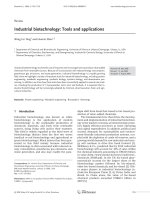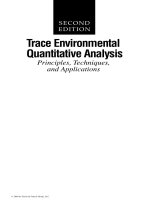Economics principles tools and applications 9th by sullivan sheffrin perez chapter 04
Bạn đang xem bản rút gọn của tài liệu. Xem và tải ngay bản đầy đủ của tài liệu tại đây (3.5 MB, 38 trang )
Economics
NINTH EDITION
Chapter 4
Demand, Supply,
and Market
Equilibrium
Prepared by Brock Williams
Copyright © 2017, 2015, 2012 Pearson Education, Inc. All Rights Reserved
Learning Objectives
4.1 Describe and explain the law of demand.
4.2 Describe and explain the law of supply.
4.3 Explain the role of price in reaching a market equilibrium.
4.4 Describe the effect of a change in demand on the equilibrium price.
4.5 Describe the effect of a change in supply on the equilibrium price.
4.6 Use information on price and quantity to determine what caused a change in price.
Copyright © 2017, 2015, 2012 Pearson Education, Inc. All Rights Reserved
DEMAND, SUPPLY, AND MARKET EQUILIBRIUM
The model of demand and supply explains how a perfectly competitive market operates.
•Perfectly competitive market
•
A market with many buyers and sellers of a homogeneous product and no barriers to entry.
Copyright © 2017, 2015, 2012 Pearson Education, Inc. All Rights Reserved
4.1 THE DEMAND CURVE
•
(1 of 5)
Quantity demanded
The amount of a product that consumers are willing and able to buy.
•
Demand schedule
A table that shows the relationship between the price of a product and the quantity demanded, ceteris paribus.
Copyright © 2017, 2015, 2012 Pearson Education, Inc. All Rights Reserved
4.1 THE DEMAND CURVE
(2 of 5)
Here is a list of the variables that affect an individual consumer’s decision, using the pizza market as an example:
•
The price of the product (for example, the price of a pizza)
•
The consumer’s income
•
The price of substitute goods (for example, the prices of tacos or sandwiches or other goods that can be consumed instead of pizza)
•
The price of complementary goods (for example, the price of lemonade or other goods consumed with pizza)
•
The consumer’s preferences or tastes and advertising that may influence preferences
•
The consumer’s expectations about future prices
Copyright © 2017, 2015, 2012 Pearson Education, Inc. All Rights Reserved
4.1 THE DEMAND CURVE
(3 of 5)
The Individual Demand Curve and the Law of Demand
•
Individual demand curve
A curve that shows the relationship between the price of a good and quantity demanded by an individual consumer, ceteris paribus.
•
Law of demand
There is a negative relationship between price and quantity demanded, ceteris paribus.
•
Change in quantity demanded
A change in the quantity consumers are willing and able to buy when the price changes; represented graphically by movement along the demand curve.
Copyright © 2017, 2015, 2012 Pearson Education, Inc. All Rights Reserved
4.1 THE DEMAND CURVE
(4 of 5)
The Individual Demand Curve and the Law of Demand
According to the law of demand, the higher the price, the smaller the quantity
demanded, everything else being equal. Therefore, the demand curve is negatively
sloped: When the price increases from $6 to $8, the quantity demanded decreases
from seven pizzas per month (point c) to four pizzas per month (point b).
Copyright © 2017, 2015, 2012 Pearson Education, Inc. All Rights Reserved
4.1 THE DEMAND CURVE
(5 of 5)
From Individual Demand to Market Demand
The market demand equals the sum of the demands of all consumers. In this case,
there are only two, so at each price the market quantity demanded equals the
quantity demanded by Al plus the quantity demanded by Bea.
At a price of $8, Al’s quantity is four pizzas (point a) and Bea’s quantity is two
pizzas (point b), so the market quantity demanded is six pizzas (point c).
Each consumer obeys the law of demand, so the market demand curve is
negatively sloped.
•
Market demand curve
A curve showing the relationship between price and quantity demanded by all
consumers, ceteris paribus.
Copyright © 2017, 2015, 2012 Pearson Education, Inc. All Rights Reserved
APPLICATION 1
THE LAW OF DEMAND FOR YOUNG SMOKERS
APPLYING THE CONCEPTS #1: What is the Law of Demand?
•
As price decreases and we move downward along the market demand for cigarettes, the quantity of cigarettes demanded increases for two reasons. First,
people who smoked cigarettes at the original price respond to the lower price by smoking more. Second, some people start smoking.
•
A change in cigarette taxes in Canada illustrates the second effect, the new-smoker effect. In 1994, several provinces in eastern Canada cut their cigarette
taxes and the price of cigarettes in the provinces decreased by roughly 50 percent. Researchers tracked the choices of 591 youths from the Waterloo
Smoking Prevention Program, and concluded that the lower price increased the smoking rate by roughly 17 percent.
Copyright © 2017, 2015, 2012 Pearson Education, Inc. All Rights Reserved
4.2 THE SUPPLY CURVE (1 of 8)
Suppose you ask the manager of a firm, “How much of your product are you willing to produce and sell?” The manager’s decision about how much to produce
depends on many variables, including the following, using pizza as an example:
•
The price of the product (for example, the price per pizza)
•
The wage paid to workers
•
The price of materials (for example, the price of dough and cheese)
•
The cost of capital (for example, the cost of a pizza oven)
•
The state of production technology (for example, the knowledge used in making pizza)
•
Producers’ expectations about future prices
•
Taxes paid to the government or subsidies (payments from the government to firms to produce a product)
Copyright © 2017, 2015, 2012 Pearson Education, Inc. All Rights Reserved
4.2 THE SUPPLY CURVE
(2 of 8)
The Individual Supply Curve and the Law of Supply
•
Quantity supplied
The amount of a product that firms are willing and able to sell.
•
Supply schedule
A table that shows the relationship between the price of a product and quantity supplied, ceteris paribus.
•
Individual supply curve
A curve showing the relationship between price and quantity supplied by a single firm, ceteris paribus.
Copyright © 2017, 2015, 2012 Pearson Education, Inc. All Rights Reserved
4.2 THE SUPPLY CURVE
(3 of 8)
The Individual Supply Curve and the Law of Supply
The supply curve of an individual supplier is positively sloped, reflecting the
law of supply.
As shown by point a, the quantity supplied is zero at a price of $2, indicating
that the minimum supply price is just above $2.
An increase in price increases the quantity supplied to 100 pizzas at a price
of $4, to 200 pizzas at a price of $6, and so on.
Copyright © 2017, 2015, 2012 Pearson Education, Inc. All Rights Reserved
4.2 THE SUPPLY CURVE
(4 of 8)
The Individual Supply Curve and the Law of Supply
•
Law of supply
There is a positive relationship between price and quantity supplied, ceteris paribus.
•
Change in quantity supplied
A change in the quantity firms are willing and able to sell when the price changes; represented graphically by movement along the supply curve.
•
Minimum supply price
The lowest price at which a product will be supplied.
Copyright © 2017, 2015, 2012 Pearson Education, Inc. All Rights Reserved
4.2 THE SUPPLY CURVE
(5 of 8)
Why Is the Individual Supply Curve Positively Sloped?
MARGINAL PRINCIPLE
Consistent with the Law of Supply, increase the level of an activity as long as its marginal benefit exceeds its marginal cost.
Choose the level at which the marginal benefit equals the marginal cost.
From Individual Supply to Market Supply
•
Market supply curve
A curve showing the relationship between the market price and quantity supplied by all firms, ceteris paribus.
Copyright © 2017, 2015, 2012 Pearson Education, Inc. All Rights Reserved
4.2 THE SUPPLY CURVE
(6 of 8)
From Individual Supply to Market Supply
The market supply is the sum of the supplies of all firms. In Panel A, Lola is
a low-cost producer who produces the first pizza once the price rises above
$2 (shown by point a).
Panel B, Hiram is a high-cost producer who doesn’t produce pizza until the
price rises above $6 (shown by point f ).
To draw the market supply curve, we sum the individual supply curves
horizontally. At a price of $8, market supply is 400 pizzas (point m), equal to
300 from Lola (point d) plus 100 from Hiram (point g).
Copyright © 2017, 2015, 2012 Pearson Education, Inc. All Rights Reserved
4.2 THE SUPPLY CURVE
(7 of 8)
From Individual Supply to Market Supply
The market supply is the sum of the supplies of all firms.
The minimum supply price is $2 (point a), and the quantity supplied
increases by 10,000 for each $2 increase in price to 10,000 at a price of
$4 (point b), to 20,000 at a price of $6 (point c), and so on.
Copyright © 2017, 2015, 2012 Pearson Education, Inc. All Rights Reserved
4.2 THE SUPPLY CURVE
(8 of 8)
Why Is the Market Supply Curve Positively Sloped?
To explain the positive slope, consider the two responses by firms to an increase in price:
•
Individual firm. As we saw earlier, a higher price encourages a firm to increase its output by purchasing more materials and hiring more workers.
•
New firms. In the long run, new firms can enter the market and existing firms can expand their production facilities to produce more output.
Copyright © 2017, 2015, 2012 Pearson Education, Inc. All Rights Reserved
APPLICATION 2
LAW OF SUPPLY AND WOOLYMPICS
APPLYING THE CONCEPTS #2: What is the Law of Supply?
•
In the 1990s, the world price of wool decreased by about 30 percent, and prices have remained relatively low since then. Based on the law of supply, we
would expect the quantity of wool supplied in New Zealand and other exporters to decrease, and that’s what happened. Land that formerly grew grass for
wool-producing sheep has been converted into other uses, including dairy products, forestry, and the domestication of deer.
•
There have been several attempts to revive the wool industry by boosting the demand for wool and thus increase its price. The United Nations General
Assembly declared 2009 as the International Year of Natural Fibers, with the objective “to raise awareness and stimulate demand for natural fibers.” In
2012, the Federated Farmers of New Zealand proposed that sheep shearing be added to the Commonwealth Games and Olympics as a demonstration
sport. Of course, it’s not obvious that Olympic shearing would increase the demand for wool, and then there is the problem of what to do with all the
sheared wool. Extreme knitting?
Copyright © 2017, 2015, 2012 Pearson Education, Inc. All Rights Reserved
4.3 MARKET EQUILIBRIUM: BRINGING
DEMAND AND SUPPLY TOGETHER (1 of 2)
•
Market equilibrium
A situation in which the quantity demanded equals the quantity supplied at the prevailing market price.
Excess Demand Causes the Price to Rise
•
Excess demand (shortage)
A situation in which, at the prevailing price, the quantity demanded exceeds the quantity supplied.
Excess Supply Causes the Price to Drop
•
Excess supply (surplus)
A situation in which the quantity supplied exceeds the quantity demanded at the prevailing price.
Copyright © 2017, 2015, 2012 Pearson Education, Inc. All Rights Reserved
4.3 MARKET EQUILIBRIUM: BRINGING
DEMAND AND SUPPLY TOGETHER
At the market equilibrium (point a, with price = $8 and quantity
= 30,000), the quantity supplied equals the quantity
demanded.
At a price below the equilibrium price ($6), there is excess
demand—the quantity demanded at point c exceeds the
quantity supplied at point b.
At a price above the equilibrium price ($12), there is excess
supply—the quantity supplied at point e exceeds the quantity
demanded at point d.
Copyright © 2017, 2015, 2012 Pearson Education, Inc. All Rights Reserved
(2 of 2)
APPLICATION 3
SHRINKING WINE LAKES
APPLYING THE CONCEPTS #3: What are the consequences of a price above the equilibrium price?
•
Under the Common Agricultural Policy (CAP) the European Union uses a number of policies to support the agricultural sectors of its member countries.
•
Under a minimum-price policy the government sets a price above the market-equilibrium price. The EU guarantees farmers minimum prices for products such as grain, dairy
products, and wine. This policy causes artificial excess supply: if the minimum price exceeds the market-equilibrium price, the quantity supplied will exceed the quantity
demanded.
•
To support the minimum prices, the EU purchases any output that a farmer cannot sell at the guaranteed price and stores the excess supply in facilities labeled by the
European press as “butter mountains” and “wine lakes.”
•
In recent years the EU has reformed its agriculture policy by reducing and in some cases eliminating minimum prices. As a result, the butter mountains and wine lakes are
shrinking.
Copyright © 2017, 2015, 2012 Pearson Education, Inc. All Rights Reserved
4.4 MARKET EFFECTS OF CHANGES IN DEMAND
Change in Quantity Demanded versus Change in Demand
•
(A) A change in price causes a change in quantity demanded, a movement
along a single demand curve. For example, a decrease in price causes a
move from point a to point b, increasing the quantity demanded.
•
(B) A change in demand caused by changes in a variable other than the
price of the good shifts the entire demand curve. For example, an increase
in demand shifts the demand curve from D1 to D2.
•
Change in demand
A shift of the demand curve caused by a change in a variable other than
the price of the product.
Copyright © 2017, 2015, 2012 Pearson Education, Inc. All Rights Reserved
(1 of 6)
4.4 MARKET EFFECTS OF CHANGES IN DEMAND
Increases in Demand Shift the Demand Curve
•
Normal good
A good for which an increase in income increases demand.
•
Inferior good
A good for which an increase in income decreases demand.
•
Substitutes
Two goods for which an increase in the price of one good increases the demand for the other good.
•
Complements
Two goods for which a decrease in the price of one good increases the demand for the other good.
Copyright © 2017, 2015, 2012 Pearson Education, Inc. All Rights Reserved
(2 of 6)
4.4 MARKET EFFECTS OF CHANGES IN DEMAND
Increases in Demand Shift the Demand Curve
Copyright © 2017, 2015, 2012 Pearson Education, Inc. All Rights Reserved
(3 of 6)
4.4 MARKET EFFECTS OF CHANGES IN DEMAND
Increases in Demand Shift the Demand Curve
An increase in demand shifts the demand curve to the right: At each price, the
quantity demanded increases.
At the initial price ($8), there is excess demand, with the quantity demanded (point
b) exceeding the quantity supplied (point a).
The excess demand causes the price to rise, and equilibrium is restored at point c.
To summarize, the increase in demand increases the equilibrium price to $10 and
increases the equilibrium quantity to 40,000 pizzas.
Copyright © 2017, 2015, 2012 Pearson Education, Inc. All Rights Reserved
(4 of 6)









